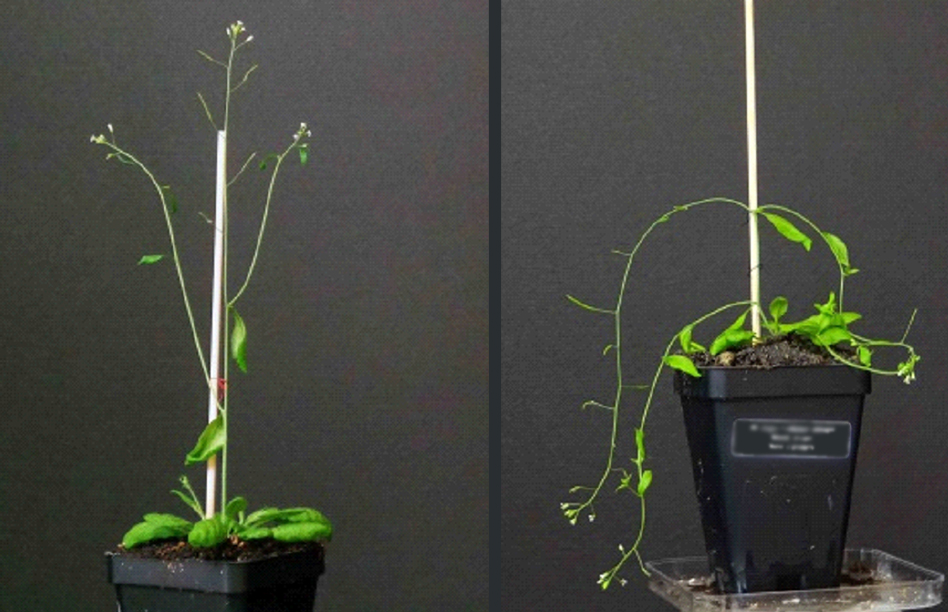Apply for the Annual Fall Research Competition, providing support across divisions

Edgar Spalding has received fall competition funding to support his efforts to understand how plants use gravity to guide plant roots and shoots in the appropriate directions.
Since she arrived at the University of Wisconsin–Madison as a faculty member in fall 2001, Aparna Dharwadker, professor of English and interdisciplinary theatre studies, has viewed the annual Fall Research Competition as an exceptional form of support for faculty research at a public institution, especially in the humanities and arts.
“Working on book-length projects in humanities disciplines is a long, drawn-out and largely self-regulated process, with limited opportunities for external grants or fellowships,” Dharwadker says. “For me and countless other colleagues, the Fall Research Competition has been an ongoing resource for focused summer research, fieldwork and other research travel, project assistantships and student hourly funds, and the development of competitive proposals for extramural grants.”
The 2021 Fall Research Competition application opened Aug. 9 and will close on Sept. 10. The yearly contest from the Office of the Vice Chancellor for Research and Graduate Education funds select research projects across each faculty division — biological sciences, physical sciences, social sciences and the arts and humanities. It is open to tenured professors and associate professors, tenure-track assistant professors and permanent PIs, and encourages collaboration.
The award comes through an annual gift from the Wisconsin Alumni Research Foundation, funded by income from commercial licenses brought in by UW–Madison faculty and staff patents. Decisions will be announced in December.
Dharwadker completed four book projects with Fall Research Competition support, and in the process also received yearlong fellowships from the American Institute of Indian Studies, the International Theatre Research Centre in Berlin and the National Endowment for the Humanities.
Her most recent book, A Poetics of Modernity: Indian Theatre Theory, 1850 to the Present, sustained by fall competition funds in multiple ways, this year received the biannual Joe A. Callaway Prize for the best book on drama or theatre published in 2018-19.
Dharwadker also finished a draft of a monograph on comparative modernist drama, entitled Cosmo-Modernism, Multilingualism, and Theatre: Modernist Performance in India, which was the basis of her fall 2020 competition proposal. She’s now sending it to publishers.
“I have been a beneficiary of fall competitions in the fullest sense and having served on the research committee for three years, have also had the opportunity to participate in the rigorous review process through which research funds are awarded in the competition,” she says.
Edgar Spalding, professor of botany, has also served on the fall competition review committee, sifting through dozens of proposals.
“I have seen what works and what does not. I would advise a new submitter to identify a compelling research question, one that a diverse group of reviewers can see as potentially impactful even if they are not experts in the area of scholarship,” he says.
A compelling idea is not necessarily enough on its own, Spalding adds. Applicants should be able to demonstrate the likelihood of success, and also convey the realistic possibility they will be able to leverage the award to earn outside support.
“The goal is to grow the university’s research impact,” Spalding says. “Ideally, that evidence will be a concrete plan to submit a larger proposal to a federal grant agency.”
Spalding has received fall competition funding to support his efforts to understand how plants use gravity to guide plant roots and shoots in the appropriate directions. Shoots and their branches do not always grow straight up, nor do roots and their branches always grow straight down. Instead, they grow at angles relative to gravity to shape the systems appropriate for that species.
His grant partially supported a postdoc and a graduate student.
“This support enabled us to obtain more data, which we used as the basis of a grant proposal submitted to the National Science Foundation,” he says. “We were awarded $918,000 to continue this research for three years, beginning in July 2021. This is a great return on the fall comp investment.”
For Pavana Prabhakar, professor of civil and environmental engineering and mechanical engineering, a fall competition grant in 2019 allowed her to fund graduate student support and generate preliminary data for writing a robust and well-thought-out NSF proposal.
Prabhakar’s research, which has since received external funding from the NSF CAREER – Mechanics of Materials and Structures (MOMS) Program through 2026, examines how fiber-reinforced polymer composite (FRPC) materials may perform in real-world settings, to help guide their design and fabrication.
The materials, Prabhakar explains, “have tremendous promise for lightweight structural applications within the aerospace, automotive and marine industries, as well as civil infrastructure due to their high strength-to-weight ratios which result in significant energy savings.”
But, they’re subject to degradation and damage from moisture in the environment, “severely limiting their use in critical applications,” says Prabhakar.
She will complement her research with a series of outreach activities focused on educating and training the next-generation workforce of engineers and scientists, which the U.S. composites industry critically needs to be competitive globally.
Alejandra Ros Pilarz and Jessica Pac, professors of social work, collaborated on a fall competition grant proposal to study inequalities in the labor market and women’s employment in jobs that are more difficult to continue doing when pregnant, such as service jobs (which are also more likely to be performed by women of color).
“We applied for the fall competition grant as back-up for a grant that we submitted to the Washington Center for Equitable Growth,” Pilarz says.
Their grant supports a research assistant for one year to help analyze survey data examining the effects of state pregnancy accommodation laws on maternal employment and economic well-being. Thirty-one states have passed laws that require employers to provide reasonable accommodations to pregnant women.
“We know that family income takes a dip around a time of a birth in part because mothers take a break from the labor market,” Pilarz says. “And there are higher rates of poverty around the time of a birth.”
Pilarz and Pac say the fall competition award accelerated their work, which is part of a bigger project looking at the effects of state pregnancy accommodation laws on maternal and child health outcomes.
“We had to be strategic in figuring out how to leverage all the different types of grants in order to get the entire project funded,” Pilarz says. “The fall competition support allows us to look at first stage effects of pregnancy accommodation laws on employment, enabling us to look at other outcomes such as infant and maternal health.”
Adds Pac: “It can sometimes be difficult to find good funding streams to support this kind of work.”
Previous competition winners share their tips for applicants
“I recommend that the proposer have already worked on the topic enough to convince the committee that they understand the challenges.”
—Edgar Spalding, professor of botany
“The fall competition is a great opportunity to get support for a graduate researcher to help generate adequate preliminary data for writing an external grant. From my experience, I believe preliminary data is key for the success of any extramural grant. My advice for a first-time applicant is that this proposal is read and discussed by faculty and/or researchers far from your area of research. Hence, it is best to minimize using too much technical jargon and write it such that it is easily understandable by researchers outside your field.”
—Pavana Prabhakar, professor of civil and environmental engineering and mechanical engineering
“Because the social sciences are so broad, it’s important to be able to explain the relevance of the project and the methods you are using to people who might not be familiar with those methods or are not subject-matter experts in the area you are researching. It’s important to be able to explain very clearly what you are doing, and why, for people from various fields.”
—Jessica Pac, professor of social work





